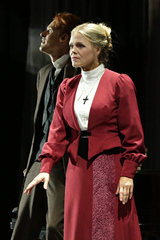| Opera Reviews | 18 May 2024 |
A psychologically intense Turn of the Screwby Michael Sinclair |
|
| Britten: The Turn of the Screw Teatro alla Scala 17 October 2016 |
|
|
Henry James’ novella, on which the opera is based, can be interpreted in many ways, whether as an ambiguous gothic ghost story or as a more complex journey into the mind of a delusional governess. Kasper Holten’s psychologically intense production seemed to lean towards the latter. Designer Steffen Aarfing set the work in a somewhat abstract setting with a sparsely furnished living room providing the main acting area, with three smaller, cell-like rooms to the side set on top of each other. The sets were predominantly white in colour, with the clinical feeling further enhanced by Ellen Ruge’s rather bright, harsh lighting. While the sets were obviously depicting the house in Bly, the designs took us to a psychological place that is clearly an integral part of the libretto and the music. The use of a front curtain that could open and close like an aperture allowed the action to be compartmentalised, heightening the feelings of claustrophobia and isolation. Overall the feeling was clinical rather than spooky; psychological rather than scary. Within this framework the production focused on the relationships between the characters, often using the cell-like rooms to present the characters in isolation, perhaps as if they were in the mind of the Governess. The eerie sense of a dysfunctional household was strongly etched, although less successful was the relationship between the children and the ghosts. While they are never intended to interact directly, the strings that bond Peter Quint and Miles, and Miss Jessel and Flora were not as clearly delineated as they could have been. Sexual ambiguity pervaded the performance. Is Mrs Grose sexually attracted to the Governess? Does the Governess harbour strong unnatural feelings towards Miles? If there were many unanswered questions, this is as it should have been. Musically the production had much to offer. Miah Persson’s Governess was pivotal to the success of the performance, with her bright, gleaming soprano able to find the multi-faceted emotions asked of her in this production. Ian Bostridge was ideal as The Prologue and Peter Quint, his bright tenor voice adding pungency and ambiguity to the other-worldly nature of these roles. Jennifer Johnston was a particularly strong voiced Mrs Grose using her rich mezzo to great effect, while Allison Cook was an effective Miss Jessel. The roles of Miles and Flora demand a great deal of the young singers who take them on. In fact, after the Governess, Miles is arguably the most important role in the opera and places huge demands on the boy soprano who plays him, both vocally and dramatically. Unfortunately, Sebastian Exall fell somewhat short on both counts. His pleasant voice was simply a few notches too small for the large auditorium, while his limited acting skills only scratched the surface of this incredibly complex role. “I am bad, I am bad,” Miles declares at the end of Act I, but there was little sense of this in Exall’s performance. On the other hand, Louise Moseley’s Flora was well sung and characterised. There is little doubt that The Turn of the Screw has one of Britten’s finest scores, and the musical language created by only 14 musicians is nothing short of extraordinary. Christoph Eschenbach led the reduced La Scala orchestra in a delicate, refined interpretation of the score from hushed pianissimos to almost Wagnerian climaxes. At the end of the performance the musicians took a bow on stage to a resounding ovation, and deservedly so.
|
|
| Text ©
Michael Sinclair Photo © Teatro all Scala |

 While the main company was on tour La Scala continued its season in Milan with a new production of Britten’s The Turn of the Screw, the first time the work has been performed in the main auditorium and in the original language. A strong cast and creative team ensured that this ‘debut’ would be worth waiting for.
While the main company was on tour La Scala continued its season in Milan with a new production of Britten’s The Turn of the Screw, the first time the work has been performed in the main auditorium and in the original language. A strong cast and creative team ensured that this ‘debut’ would be worth waiting for.





